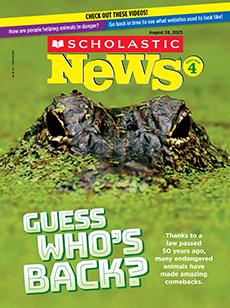A Sumatran rhinoceros named Indra trails behind his mother, Delilah. They splash around in a mud puddle before lying down side by side for a nap.
Indra may seem like an ordinary rhino. But his birth last November at a sanctuary in Indonesia was cause for celebration. It followed the birth of another Sumatran rhino—a female named Anggi. She was born at the same sanctuary just two months before.
Why were their births such big news? Sumatran rhinos are among the most endangered animals on Earth. By some estimates, fewer than 50 of them are left in the wild.
“Sumatran rhinos are really rare,” explains Stacy Strother. She works for the International Rhino Foundation. “So for this species, literally every single birth is a really big deal.”
Indra is a baby Sumatran rhinoceros. He trails behind his mother, Delilah. They splash around in a mud puddle. Then they lie down side by side for a nap.
Indra may seem like an ordinary rhino. But his birth last November at a sanctuary in Indonesia was cause for celebration. It followed the birth of another Sumatran rhino, named Anggi. She was born at the same sanctuary just two months before.
Why were their births such big news? Sumatran rhinos are among the most endangered animals on Earth. By some estimates, fewer than 50 of them are left in the wild.
“Sumatran rhinos are really rare,” explains Stacy Strother. She works for the International Rhino Foundation. “So for this species, literally every single birth is a really big deal.”

